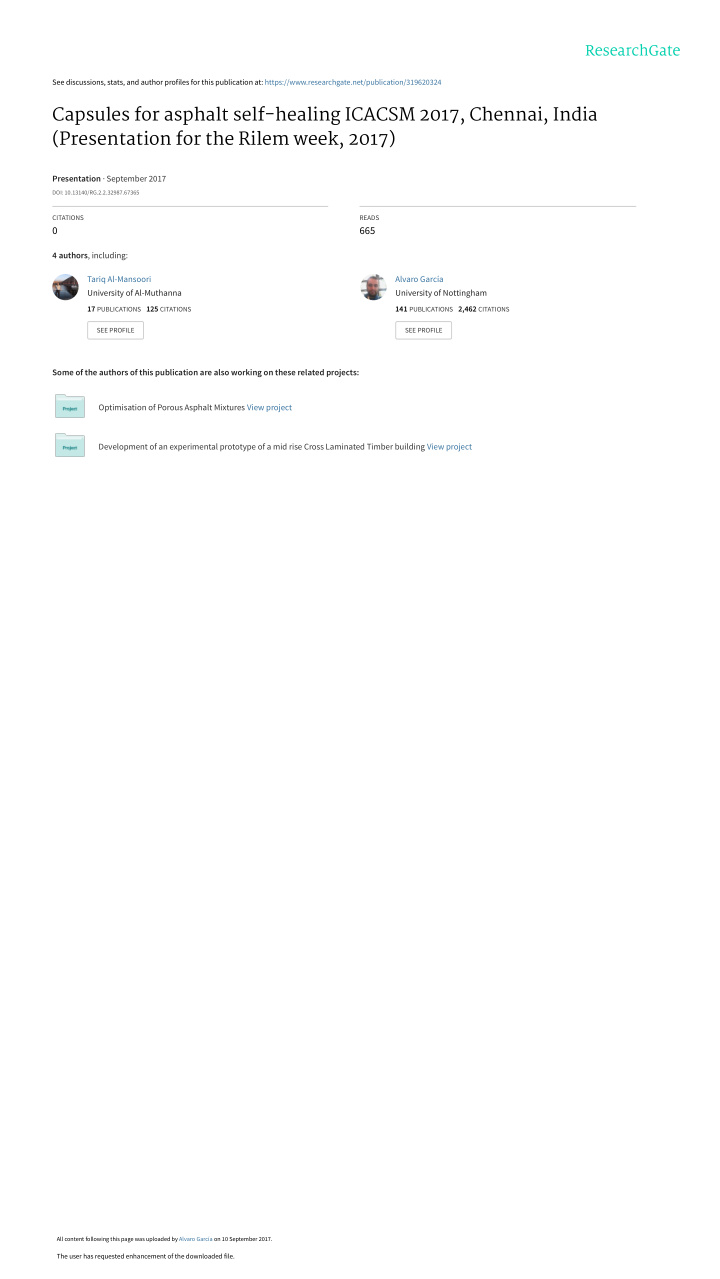



See discussions, stats, and author profiles for this publication at: https://www.researchgate.net/publication/319620324 Capsules for asphalt self-healing ICACSM 2017, Chennai, India (Presentation for the Rilem week, 2017) Presentation · September 2017 DOI: 10.13140/RG.2.2.32987.67365 CITATIONS READS 0 665 4 authors , including: Tariq Al-Mansoori Alvaro García University of Al-Muthanna University of Nottingham 17 PUBLICATIONS 125 CITATIONS 141 PUBLICATIONS 2,462 CITATIONS SEE PROFILE SEE PROFILE Some of the authors of this publication are also working on these related projects: Optimisation of Porous Asphalt Mixtures View project Development of an experimental prototype of a mid rise Cross Laminated Timber building View project All content following this page was uploaded by Alvaro García on 10 September 2017. The user has requested enhancement of the downloaded file.
Capsules for asphalt self-healing ICACSM 2017, Chennai UK UK Portugal Chile Mr T. Al Mansouri Dr R. Micaelo Dr A. García Dr J. Norambuena
Outline 1. Introdution to asphalt self-healing 2. Capsules for asphalt self-healing 3. Results 4. Conclusions
Roads suffer constant damage Performance • Cracking • Time dependent degradation • Ingress agressive substances Time
Asphalt self-healing Asphalt self-healing Problem: This process may take several days or weeks to complete. Crack Crack Asphalt concrete h p F F t t ( h ) gh p F F f gh h Contact point F F d d Healing material F Hydrostatic force f F Weight of the healing material h F Surface tension force 0 F F F F t f h t d F Losses (friction, etc) d García A, (2011), “Self - Healing of open cracks in asphalt mastic”, FUEL. Fuel 93, 264 -272.
Asphalt self-healing. The solution Mechanical loading and/or moisture degrade the capsules that release the oil wherever it is more needed. Asphalt Broken capsule Local reduction of bitumen viscosity (This promotes the drainage of bitumen into the cracks) Healing material
Inspiration MasterChef
Asphalt self-healing. Encapsulation procedure. 20 o C Sunflower oil Alginate Drops fall into the solution 2% Calcium solution
This is one of our capsules… The capsules have an internal porous structure that contains approx. 80% oil
… this is how we mix the capsules in asphalt … In the laboratory In the asphalt plant or Mixing temperature: 180 o C Capsule • aprox. 20 s before the end of the mixing process, at the ambient temperature • <0.5% by weight of total mixture. 1 ton of asphalt <5kg of capsules
…and this is asphalt containing capsules. Capsule
…and this is asphalt containing capsules. Note: this is dense asphalt mixture, maximum size of aggregates 20mm that has been roller-compacted at 140 o C.
This is how we test self-healing Healing level = strength before resting/strength after resting 150 mm 100 mm Step A: Break the beam F -20 ºC 60 mm Step C Notch 5 mm Step B. 100 mm Break the capsules Healing time: 6 - 192 h F Steel plate + 20 ºC Temperature chamber + 20 ºC 1. Place a flexible plastic membrane in the crack Plastic 2. Compress the beam membrane Steel mould 3. Remove the plastic membrane
Capsules resist mixing and compaction We simulate many years of traffic by compressing the test samples. In this way we can break the capsules and release the oil. F 100 Steel plate + 20 ºC Before compression 90 After compression 80 Plastic 70 membrane Steel mould 56.31 60 49.2 0 50 40 Capsules broke during compression. 31.29 30 20 10 1.53 1.12 1.27 Capsules resisted mixing and compaction. 0 0.10 Caps 0.25Caps 0.50Caps Capsule content in mixture (%)
Asphalt self-healing Remember: Healing level = strength before resting/strength after resting 100 WO/C No capsules 90 0.10% Caps 80 Healing level (%) 0.25% Caps 70 0.50% Caps 60 50 40 30 20 10 0 0 50 100 150 200 Time (h)
Effect of temperature on asphalt self-healing 100 100 With capsules WO/C No capsules Maximum healing level (%) 90 90 Without capsules 0.10% Caps 80 80 Healing level (%) 0.25% Caps 70 70 0.50% Caps 60 60 50 50 40 40 30 30 After 100 h 20 20 resting 10 10 0 0 -5 5 15 25 35 45 55 0 50 100 150 200 Healing temperature ( o C) Time (h)
Properties or asphalt mixture 1. Air void content 2. Particle loss test 3. Water sensitivity 4. Rutting susceptibility 5. Stiffness modulus 6. Fatigue life
Properties or asphalt mixture
Conclusions 1. Capsules containing healing agents can be mixed in asphalt and resist mixing and compaction. 2. Capsules improve asphalt self-healing of asphalt mixture, even at low temperatures. 3. Mechanical properties of asphalt mixture are not truly affected by the presence of capsules. 4. Our capsules are too big. They should be smaller, to avoid affecting fatigue life. 5. Capsules for asphalt self-healing are ready to be tested on-site.
Thank you alvaro.garcia@nottingham.ac.uk October 2017. First trial of a self-healing road with capsules!! View publication stats View publication stats
Recommend
More recommend